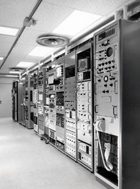Institute for Telecommunication Sciences / Research / Table Mountain / Chapter 4: Space Disturbances Laboratory
Chapter 4: Space Disturbances Laboratory
The Space Disturbances Laboratory conducts research into the nature of space disturbances in order to improve our understanding of these disturbances, including the mechanisms responsible for producing them and their consequences on man's use of the earth's upper atmosphere and outer space. Specific studies include: the basic nature of the solar outburst mechanism and the ability to describe and predict flares and other solar events; the interaction of solar plasma streams with the earth's magnetosphere and other elements of the environment including the earth's upper atmosphere and magnetic field.
The results of these studies contribute significantly to the scientific community as a whole. Also information is provided to designers of telecommunication systems, spacecraft, and supersonic transports, and those concerned with hazards to astronauts and equipment operating in the environment, and the prediction of telecommunications disturbances and fluctuations in the earth's magnetic field.
The Laboratory is also developing a comprehensive space disturbance monitoring and forecasting system. Techniques are being developed to continuously monitor and report those characteristics of the space environment necessary for the early detection of important disturbances. This includes also the preparation of predictions of the occurrence of solar-associated disturbances of various kinds as well as the collection, dissemination, and publication of a wide variety of solar and geophysical data.
This Laboratory operates a number of field experimental facilities and observatories throughout the world. These are managed directly, under contract, or on a cooperative basis with participating organizations. Some of the experimental facilities, as well as the Boulder Magnetic Observatory, are located in the Boulder area.
Boulder Magnetic Observatory
The Boulder Magnetic Observatory is a cooperative observatory, established in April 1963, by agreement between the National Bureau of Standards and the U. S. Coast and Geodetic Survey. The installation, located on Table Mountain, includes a standard magnetograph, a rapid-run magnetograph and suitable modern instrumentation for accurate base-line control and calibration. A flux gate magnetometer provides real-time horizontal intensity information which is monitored by a recorder in the Space Disturbance Forecasting Center of I.T.S.A. The magnetic data are used directly by research scientists of I.T.S.A. and the U.S.C.G.S. and are available to the scientific community on a national and international basis.
High Altitude Nuclear Detection Studies (HANDS Facility)
A project was established, at the request of the Advanced Research Projects Agency, for the purpose of defining techniques which could be used to detect high altitude nuclear detonations. This activity called High Altitude Nuclear Detection Studies (HANDS) resulted in considerable research and development of various types of sensors which might detect effects from high altitude nuclear detonations, in the presence of natural background phenomena. To assist in this work, a facility was built on Table Mountain which represents a collection of numerous radio, optical, acoustic and magnetic sensors which are systematically monitoring geophysical effects. The resulting data are immediately analyzed by an "on-line" computer which determines within a few minutes whether or not a "disturbance" has occurred in the earth's environment. A natural "by-product" is the automatic detection of solar flare effects. This facility is thus an essential ingredient to the Laboratory's Space Disturbance Forecast Center. It should also be noted that a number of the sensors for the HANDS facility are located in the adjacent areas, for example, an infrasonics probe and a riometer receiver.








